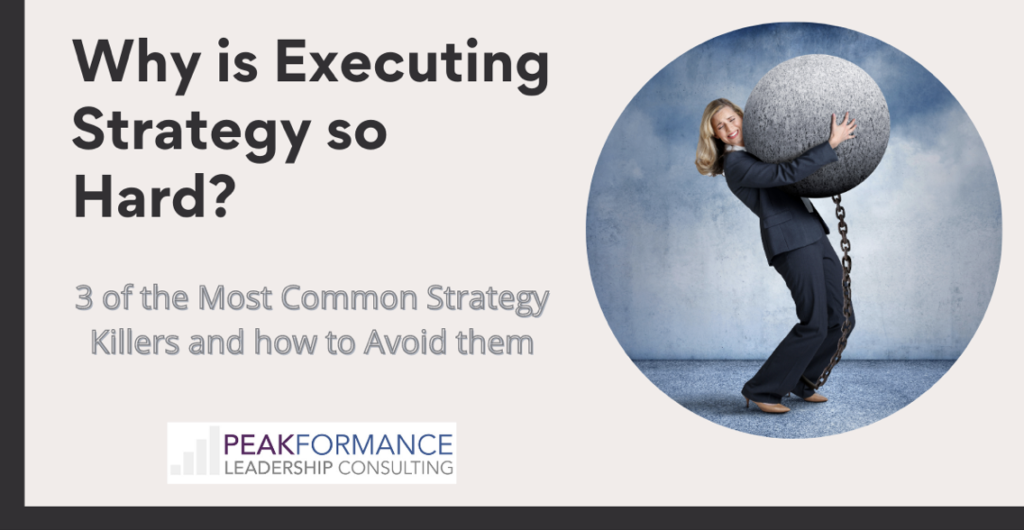3 of Most Common Strategy Killers and how to Avoid them
Is there anything more satisfying than experiencing your team take ownership of a plan and successfully execute it? The essence of leadership pride! Unfortunately, more often than not strategic plans either fail to meet expectations, or worse yet, they fade into oblivion. Many research studies indicate that more than two-thirds of strategic plans fail to meet expectations because of poor execution. Executive leaders consistently identify strategic execution as one of their biggest challenges. It is all too common for teams to develop carefully thought-out strategies but then struggle to execute them. There are many reasons that strategies fail to meet expectations. Following are what we consider to be 3 of the most common strategy killers and some suggestions on how to avoid them:
An Outdated Planning Process
In the past most organizations conducted planning sessions on an annual basis, and it worked reasonably well. However, in today’s dynamic environment where change and innovation are occurring at light speed, strategic planning once a year is not sufficient. A plan that does not continuously consider the current landscape, changing dynamics, and trends is much more likely to become stale and misdirected. Nothing will cause strategic execution to lose momentum more than a plan that becomes irrelevant.
Develop a Agile Planning Process – It is important to think of strategic planning as more of an evolution that an event. A more frequent planning cadence is necessary to develop and manage strategy in a dynamic environment. Ideally developing a planning framework that is administered quarterly will help your organization become more strategically agile. It will enable the team to identify and collaborate on changing dynamics and adapt more quickly. Evaluating strategy more frequently will also keep it top of mind and continue to build ownership.
Lack of Execution Ownership
One of the most common strategy killers is the lack of execution ownership. Ownership is not about who does the work (Ok, it is partially the case) but the extent to which the team is invested in the strategy. It is very hard to get a team to own a strategy if they are not inspired by it. Often, strategies are fully conceived by leaders and then unceremoniously passed off to the team to execute. This causes it to be perceived as just more work – hardly inspirational!
Inclusiveness Builds Ownership: Nothing gets the team more excited about strategy that contributing to developing it. That doesn’t mean you invite the entire team to a strategy session. That would be chaos. But there are very effective ways to engage the team in the preparation process. Getting client feedback, market analysis, conducting a department SWOT (strengths, weaknesses, opportunities, threats) analysis, are just some of the things that can be done to connect the team to the strategy. Then keeping the team engaged in strategy consideration throughout will inspire the ownership and enthusiasm necessary to drive progress!
Organizational Strain – In today’s hyper busy workplace maintaining a focus on a strategic plan is more challenging than ever. Stakeholders are increasingly expecting immediate results and are becoming less willing to allow long-term strategies to take shape. Leaders are challenged to balance investing time and energy in a longer-term plan and keeping the business functioning day-to-day. When it causes organization strain leaders have a tendency to shift attention back to the business at hand and strategy takes a back seat.
Align Strategy & Execution Capacity: Narrowing the scope of the strategic plan can balance expectations and achievement. Establishing reasonable goals that can be executed in the current quarter will demonstrate progress to stakeholders without overburdening the organization. It is also important to establish clearly defined execution goals and build accountability into normal routines to reinforce commitment. A framework that is executed with discipline will result in incremental progress from quarter to quarter – and that can really add up over time.
Whether your team is effective at executing strategy or challenged by it, take some time to reflect on your process and identify opportunities to improve it. Execution can always be improved. An agile and evolving planning process, making sure the team is invested in and inspired by the strategy, and positioning your organization for success will provide a great foundation for execution.
PeakFormance specializes in helping clients develop effective strategic planning frameworks that work for their organizations. We also work alongside them to guide the strategy evolution and maintain execution continuity that produce results. If we can help you and your team develop and administer an effective strategic planning process, please contact us. www.peakformanceconsulting.com/contact
